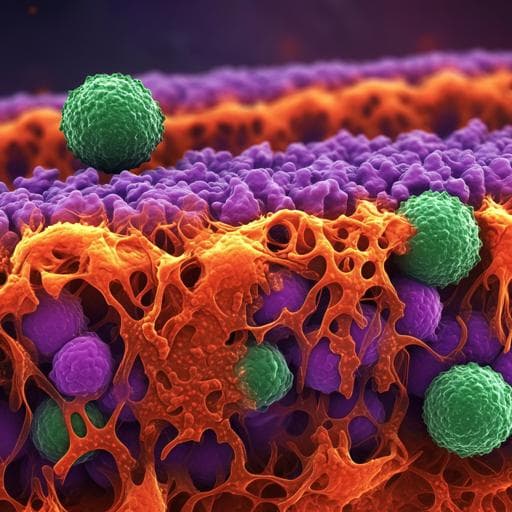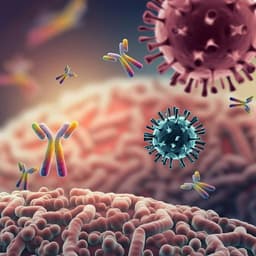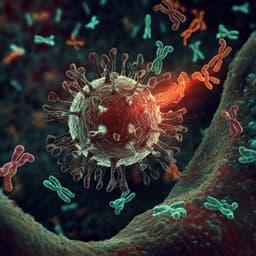
Medicine and Health
Maternal-fetal immune responses in pregnant women infected with SARS-CoV-2
V. Garcia-flores, R. Romero, et al.
This groundbreaking study reveals how SARS-CoV-2 infection during pregnancy uniquely triggers inflammatory responses at the maternal-fetal interface, primarily orchestrated by maternal T cells and fetal stromal cells. Conducted by a team of experts including Valeria Garcia-Flores and Roberto Romero, the research highlights important aspects of maternal-fetal immune interaction and confirms that the placental tissue remains sterile despite the infection.
~3 min • Beginner • English
Introduction
The study investigates how SARS-CoV-2 infection during pregnancy affects maternal, placental, and neonatal (fetal) immune responses, and whether the placenta harbors the virus. Pregnant women are at elevated risk for severe/critical COVID-19 and adverse outcomes such as ICU admission and preterm birth. Most neonates born to infected mothers test negative and are asymptomatic or mildly affected; confirmed in utero transmission is rare but documented, likely via hematogenous spread requiring placental traversal. Canonical viral entry mediators (ACE2 and TMPRSS2) show negligible co-expression in placental cells across gestation, though non-canonical entry routes may exist. Placental ischemic injury may facilitate viral entry. Given these uncertainties and potential harms of maternal inflammation for offspring, this study aims to characterize maternal-fetal immune responses using serology, cytokine profiling, immunophenotyping, scRNA-seq of placental tissues, bulk blood transcriptomics, viral RNA/protein detection, and placental microbiome assessment.
Literature Review
Prior work shows pregnant women with SARS-CoV-2 face higher risks of hospitalization, ventilation, ICU admission, and preterm birth, with increased severity and mortality compared to non-pregnant women in later analyses. Neonatal infection is uncommon and generally mild; vertical transmission can occur but is rare, with in utero cases documented. Viral entry via ACE2 and TMPRSS2 is typical; however, in the placenta, ACE2/TMPRSS2 co-expression is negligible, although other mediators (e.g., CTSL, FURIN, SIGLEC1) are expressed, and vascular/ischemic injury may enhance susceptibility. Reports exist of placental infection, but placental positivity alone does not prove in utero transmission. Maternal IgG is known to cross the placenta; reports variably show neonatal IgM, which would indicate fetal infection, but most studies do not find cord blood IgM. Cytokine storms contribute to COVID-19 pathophysiology in non-pregnant adults. Lymphopenia, particularly affecting T cells, associates with severe COVID-19; pregnant women with mild/asymptomatic infection may also show reduced lymphocyte counts. Evidence regarding placental microbiota largely supports a sterile womb hypothesis, with mode of delivery influencing detected bacterial DNA signals due to exposure during vaginal birth.
Methodology
Design and participants: Cross-sectional study of 23 pregnant women at a single center. Twelve tested RT-PCR positive for SARS-CoV-2 (nasopharyngeal); 8 asymptomatic, 1 mild, 3 severe (requiring oxygen). One severe case had indicated preterm cesarean for worsening respiratory status; most others delivered at term. Neonates were not RT-PCR tested for SARS-CoV-2. Demographics and clinical characteristics did not differ between groups.
Sampling: Maternal peripheral blood collected upon admission before medications; umbilical cord blood and placental tissues (chorioamniotic membranes [CAM], placental villi [PV], basal plate [BP]) collected immediately after delivery. Placentas underwent standardized histopathology.
Serology and cytokines: Measured SARS-CoV-2-specific IgM/IgG in maternal serum and cord blood. Quantified 20 cytokines in maternal and cord plasma using multiplex assays. Statistical comparisons used Mann–Whitney U tests (serology), linear mixed-effects models with covariate adjustment (cytokines), PCA and logistic regression for association with infection status.
Immunophenotyping: Flow cytometry on maternal and cord blood to enumerate leukocyte subsets and detailed T-cell (CD4+, CD8+; naïve, central memory [TCM], effector memory [TEM], TEMRA; Th/Tc-like subsets) and B-cell/monocyte/neutrophil subsets; assessed ROS production by neutrophils/monocytes upon stimulation. Analyses used Mann–Whitney U tests, heatmaps (Z-scores), FDR-adjusted t-tests, and PCA.
Placental scRNA-seq: Generated single-cell transcriptomes from CAM and combined PV+BP (PVBP) using 10x Genomics. Processed with Cell Ranger, kallisto|bustools, DIEM, and integrated using Seurat and Harmony; cell types annotated via SingleR and prior references. Pseudobulk DE analysis per cell type/location/origin using DESeq2 with batch adjustment; FDR q<0.1 threshold. Compared maternal T-cell DEGs with a reference dataset of peripheral T cells from COVID-19 patients. Enrichment analyses via GO, KEGG, Reactome, and STRING.
Bulk RNA-seq: RNA from maternal blood (n=10 control, 11 infected) and cord blood (n=8 control, 9 infected) processed with Salmon and DESeq2 including covariates (maternal age, BMI, nulliparity, labor status, delivery route). DEGs defined by FC>1.25 and q<0.1; GO/KEGG over-representation assessed. Correlated bulk signatures with placental scRNA-seq signatures by cell type via Spearman correlation.
Placental SARS-CoV-2 detection: Searched scRNA-seq raw data for viral reads using Viral-Track; validated pipeline on bronchoalveolar lavage COVID-19 controls. Performed RT-qPCR for N1/N2 genes on CAM, BP, PV (fresh tissues and FFPE sections corresponding to IHC signals) with positive/negative controls; sensitivity assessed by spike-in experiments determining minimum detectable viral copies (down to 10 copies in PV). IHC for spike and nucleocapsid proteins on FFPE PV/BP/CAM with appropriate controls.
Placental microbiome assessment: Swabbed CAM, amnion-chorion interface of placental disc (AC), and placental villous tree (VT). Quantified bacterial DNA via 16S rRNA gene qPCR; profiled communities by V4 16S rRNA gene sequencing (MiSeq), processed with DADA2 and decontam; analyzed Bray–Curtis dissimilarities, PCoA, and PERMANOVA; evaluated impact of mode of delivery and infection status.
Statistics: Detailed in Methods; significance thresholds p<0.05 or q<0.1 as applicable.
Key Findings
- Study cohort: 23 pregnant women; 12 SARS-CoV-2 RT-PCR positive (8 asymptomatic, 1 mild, 3 severe). Most delivered at term; one severe case delivered preterm by cesarean for respiratory deterioration. Neonates were not RT-PCR tested.
- Serology: Mothers with SARS-CoV-2 had higher serum IgM and IgG than controls. Cord blood from neonates of infected mothers had increased IgG but undetectable IgM, similar to controls, implying no evidence of in utero fetal infection in this largely asymptomatic cohort.
- Cytokines: In maternal plasma, increased IL-8 (5.9-fold), IL-10 (2.3-fold), and IL-15 (1.5-fold) versus controls; effects were not driven solely by severe cases. In cord blood, IL-8 increased 2-fold; other cytokines showed no significant differences. PCA of cytokine profiles associated with infection status for mothers (p=0.034) and neonates (p=0.032).
- Immunophenotyping: Total T cells reduced in maternal blood of infected women (p=0.007); no reduction in cord blood T cells. Specific maternal T-cell subsets decreased: CD4+ T cells (including TCM and Th1-like) and CD8+ T cells (including TCM, TEM, and Tc17-like). Neonatal T-cell subsets did not mirror these reductions.
- Placental scRNA-seq: Major DEGs localized to CAM maternal immune cells and fetal stromal cells. Maternal T cells in CAM had 89 DEGs; maternal macrophages (Macrophage-2) 12 DEGs; decidual and LED cells 12 and 11 DEGs, respectively; fetal stromal cells (CAM) 59 DEGs. Minimal changes in fetal trophoblasts and fetal T cells in CAM and PVBP. Maternal CAM T-cell gene changes correlated with peripheral T-cell changes from COVID-19 patients (Spearman ρ=0.27, p=0.004); PVBP maternal T cells did not (ρ=0.009, p=0.62). Enriched pathways included interferon signaling, TNF signaling, antigen presentation; KEGG enrichments: TNF signaling (Decidual), cytokine–cytokine receptor interaction (maternal Macrophage-2), COVID-19 (fetal Stromal-1), degenerative disease-related processes (maternal T cells). STRING analysis confirmed interferon pathway enrichment.
- Blood transcriptomics: Maternal and cord blood transcriptomes modestly correlated (Spearman ρ=0.24; p<0.001). Each compartment showed 425 DE transcripts with infection: maternal blood 165 up/260 down (upregulated processes: complement activation, adaptive immunity, immunoglobulin-mediated response; downregulated: phagocytosis, ECM organization); cord blood 131 up/294 down (upregulated: defense responses to fungus/bacterium; no significant processes among downregulated). Interaction analysis identified 34 genes with significantly different maternal vs cord responses, enriched for phagocytosis and complement activation in maternal blood. Maternal blood signatures correlated positively with CAM maternal T cell, Macrophage-2, and Monocyte signatures; cord blood negatively correlated with PVBP fetal T-cell signatures.
- Placental viral detection: No SARS-CoV-2 reads detected in placental scRNA-seq (CAM or PVBP) by Viral-Track, though positive controls were detected. RT-qPCR did not detect N1/N2 RNA in any placental tissues (fresh or FFPE); spike-in controls were positive; sensitivity reached 10 viral copies in PV. IHC showed occasional putative signals in a few asymptomatic cases, but corresponding RT-qPCR was negative; overall, spike and nucleocapsid proteins were not detected in placentas of infected or control women, except in spike-in positive controls.
- Placental microbiome: Mode of delivery, not maternal infection, was the principal determinant of bacterial DNA load and profiles. Most cesarean-delivered samples resembled technical controls (low bacterial DNA), whereas vaginally delivered samples had higher bacterial DNA and profiles dominated by Lactobacillus and Ureaplasma, similar to vaginal swabs. Among vaginal deliveries, bacterial profiles did not differ by maternal SARS-CoV-2 status.
Overall, maternal SARS-CoV-2 infection is associated with maternal systemic and local (maternal-fetal interface) inflammatory responses, a mild neonatal cytokine response, and transcriptomic alterations in fetal stromal cells, without evidence of placental infection or neonatal T-cell repertoire compromise.
Discussion
Findings indicate that SARS-CoV-2 infection during pregnancy elicits maternal inflammatory responses systemically and at the maternal-fetal interface. Elevated maternal IL-8, IL-10, and IL-15 and reduced maternal T-cell subsets (including pro-inflammatory Th1- and Tc17-like cells) are consistent with known COVID-19 lymphopenia and may impact maternal-fetal tolerance. Neonates exhibited a mild inflammatory signal (elevated IL-8) and transcriptomic changes implicating innate defense processes, suggesting neonatal immune activation despite absent evidence of in utero infection and no T-cell repertoire reduction.
At the placenta, scRNA-seq revealed prominent responses in maternal T cells and macrophages within CAM and significant modulation of fetal stromal cell transcriptomes, while fetal immune cells and trophoblasts were minimally affected. Pathway analyses underscored interferon and TNF signaling and cytokine–receptor interactions, aligning with antiviral responses. Correlations between maternal blood and CAM maternal immune cell signatures support coordinated systemic and local immune activation. The lack of detectable viral RNA or proteins in placental tissues, coupled with absent cord blood IgM, emphasizes that placental infection is rare in largely asymptomatic infections and that neonatal immune effects may be driven by maternal inflammation or cytokine transfer (e.g., IL-8) rather than direct fetal infection. Mode of delivery, not infection status, influenced placental bacterial DNA, indicating that SARS-CoV-2 does not compromise placental sterility.
These results address the research question by demonstrating distinct maternal and fetal (stromal) immune alterations without placental infection, informing understanding of COVID-19’s impact on pregnancy and potential neonatal immune priming.
Conclusion
SARS-CoV-2 infection in pregnancy primarily induces inflammatory responses at the maternal-fetal interface dominated by maternal T cells and macrophages and affects fetal stromal cell transcriptomes. Mothers exhibit humoral responses and selective T-cell lymphopenia; neonates show a mild cytokine response (elevated IL-8) without IgM production or T-cell repertoire compromise. No SARS-CoV-2 RNA or proteins were detected in placental tissues, and placental sterility was not altered by maternal infection. The study advances understanding of maternal-fetal immune dynamics in COVID-19 and underscores the rarity of placental infection. Future work should longitudinally assess neonatal outcomes, delineate mechanisms of cytokine transfer and fetal stromal cell involvement, and evaluate effects across disease severities and timing of infection.
Limitations
- Cross-sectional design precludes establishing temporal dynamics or disease progression.
- Neonates were not RT-PCR tested; fetal infection status inferred indirectly (serology, placental assays).
- Small sample size with few severe COVID-19 cases, limiting power and generalizability, particularly for severe disease.
- Assay-specific sample sizes varied (e.g., cytokines, RNA-seq, flow cytometry), potentially affecting detection of differences.
- Findings largely reflect a cohort with asymptomatic or mild disease; results may differ in more severe or early-gestation infections.
Related Publications
Explore these studies to deepen your understanding of the subject.







